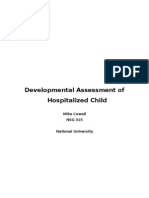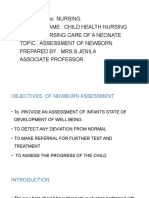Anthropometric Procedures
Anthropometric Procedures
Uploaded by
drkrishnaswethaCopyright:
Available Formats
Anthropometric Procedures
Anthropometric Procedures
Uploaded by
drkrishnaswethaCopyright
Available Formats
Share this document
Did you find this document useful?
Is this content inappropriate?
Copyright:
Available Formats
Anthropometric Procedures
Anthropometric Procedures
Uploaded by
drkrishnaswethaCopyright:
Available Formats
Anthropometric Procedures
Background Length Weight Head Circumference Background The term anthropometric refers to comparative measurements of the human body. The anthropometric measurements commonly used as indices of growth and development for infants include length, weight, and head circumference. Typically, growth is evaluated by comparing individual measurements to reference standards, represented by percentile curves on a growth chart. In assessing and monitoring the nutritional status of a low birth weight infant it is most helpful to evaluate a pattern of measurements obtained on a regular basis over time. For anthropometric measurements to be valid indices of growth status, they must be highly accurate, requiring precision in measuring technique. Accurately measuring children with physical abnormalities is often a challenge. Length Measurement Equipment: Use a length-measuring device with a fixed headboard and a moveable footboard that are perpendicular to the surface on which the child is lying. A fixed measuring tape, marked in millimeters or in 1/16 in. segments, should be attached to the surface with the zero end at the edge of the headboard. Several commercial versions of length boards are available. Technique: Two people are required to measure length accurately:
Person A 1. Hold the head with crown against the headboard so that the child is looking straight upward. 2. Make sure the trunk and pelvis are properly aligned with the measuring device. Person B 1. Straighten the child's legs and hold the ankles together with the toes pointed directly upward. 2. Move the footboard firmly against the soles of the feet. 3. Read the measurement to the nearest 0.1 cm (1/8 in). 4. Repeat the measurement until two measurements agree within 0.2 cm (1/4 in). 5. Record the numerical value and plot length for age on the appropriate growth chart. 6. If the child is uncooperative and you cannot get an accurate measurement, record your best estimate on the growth chart and note the circumstances of the measurement.
Weight Measurement Equipment: Use a beam scale with non-detachable weights or an equally accurate electronic scale. For infants and young children who are weighed lying down use a pantype pediatric scale that is accurate to within 10 gram or 1/2 oz. Do not use spring-type bathroom scales; with repeated use, they may not maintain the necessary degree of accuracy. Frequently check and adjust the zero weight on the beam scale by placing the main and fractional sliding weights at their respective zeros and moving the zeroing weight until the beam is in balance at zero. If a pad or diaper is used to make the pan more comfortable, place it in the pan when the zero adjustment is made; otherwise the weight of the pad or the diaper must be subtracted from the weight of the child each time a measurement is made. Whichever method is used to account for the weight of the diaper or pad, note it on the growth chart. At least two or three times per year, have the accuracy of the scale checked with a set of standard weights by a local dealer or inspector of weights and measures. Technique:
1. Remove all clothing including the diaper and place the infant in the center of the weighing surface. 2. Read the measurement to the nearest 10 gram or 1/2 oz. 3. Repeat the measurement two to three times and, after excluding those that are obviously wrong, average the values. 4. Record the numerical value on the growth chart and plot weight for age and weight for length on the appropriate growth chart(s) Note: It's not always possible to plot weight for length on small infants with lengths below 55 cm. 5. If the infant moves excessively, an accurate measurement is unlikely; postpone the measurement for a few minutes. 6. If the infant still does not keep still, skip the measurement unless you can make a reasonable estimate. If the weight you record on the growth chart is an estimate, note the circumstances on the growth chart. Head Circumference Measurement The measurement of head circumference is an important screening procedure for detecting abnormalities of head growth. Although usually caused by nonnutritional factors, slow head growth can be a result of severe under nutrition. Children with poor head growth frequently have poor linear growth as well. Thus knowledge of head size is very important in assessing possible nutritional factors contributing to short length or stature. Head circumference should be measured routinely until at least 36 months of age. Equipment: Use a flexible, nonstretchable measuring tape. Technique: 1. Position the child standing or in a sitting position in the lap of the caregiver. 2. Place the lower edge of the measuring tape just above the child's eyebrows, above the ears and around the occipital prominence at the back of the head. 3. Pull the tape snugly to compress the hair. The objective is to measure the maximal head circumference. 4. Repeat the measurement twice or until two measurements agree to 0.1 cm (1/8 in). 5. Record the numerical value immediately and plot on the growth chart. 6. If the measurement appears abnormal when plotted, check the accuracy of plotting and recheck the measurement.
Nutrition Assessment: Growth Homepage Gaining and Growing Homepage
More information contact: Joan Zerzan Page reviewed: 3/20/2007
You might also like
- ABS-950 Baggage Scale ManualDocument51 pagesABS-950 Baggage Scale ManualSohail75% (8)
- Template Weighing Scale - ManualDocument4 pagesTemplate Weighing Scale - ManualMohd Ezan MohammadiahNo ratings yet
- International Standard Test Method For RopesDocument26 pagesInternational Standard Test Method For RopesTziouris VasileiosNo ratings yet
- All in Trans Clinical ChemistryDocument114 pagesAll in Trans Clinical ChemistryRicardo Lorenzo AlasNo ratings yet
- ATPLessentials: Mass and BalanceDocument2 pagesATPLessentials: Mass and BalanceATPLessentials80% (5)
- Profile of The NewbornDocument5 pagesProfile of The NewbornNIKAH PAULINE ALCANTARANo ratings yet
- Complementary Feeding or WeaningDocument2 pagesComplementary Feeding or WeaningSumita JainNo ratings yet
- Growth and Developments PDFDocument3 pagesGrowth and Developments PDFAlok SharmaNo ratings yet
- Asphyxia NeonatorumDocument8 pagesAsphyxia NeonatorumTheresa MendoncaNo ratings yet
- Hospitalized ChildDocument30 pagesHospitalized Childjulie kiskuNo ratings yet
- Postmature Infants 1Document13 pagesPostmature Infants 1LyssaMarieKathryneEge100% (1)
- Hydronephrosis in ChildrenDocument9 pagesHydronephrosis in ChildrenJoshua De Paz TortugoNo ratings yet
- PhototherapyDocument28 pagesPhototherapySudha YadavNo ratings yet
- Silpa Jose T MSC (N) Lecturer Stcon, KattanamDocument40 pagesSilpa Jose T MSC (N) Lecturer Stcon, KattanamSilpa Jose TNo ratings yet
- History Taking in ChildrenDocument13 pagesHistory Taking in ChildrenjasmineNo ratings yet
- Adjustment To Extra Uterine LifeDocument51 pagesAdjustment To Extra Uterine LifeJagadeeswari JayaseelanNo ratings yet
- Anthropometric Measurements, Plotting and InterpretationDocument31 pagesAnthropometric Measurements, Plotting and Interpretationokwadha simionNo ratings yet
- A Study To Evaluate The Effectiveness of Structured Teaching Program On Knowledge and Practice Regarding Kangaroo Mother Care Among Post Natal Mothers Having Low Birth Weight Babies 1 PDFDocument9 pagesA Study To Evaluate The Effectiveness of Structured Teaching Program On Knowledge and Practice Regarding Kangaroo Mother Care Among Post Natal Mothers Having Low Birth Weight Babies 1 PDFManisa ParidaNo ratings yet
- Pyloric StenosisDocument8 pagesPyloric StenosisRej PanganibanNo ratings yet
- Congenital SyphilisDocument1 pageCongenital SyphilisDelphy VargheseNo ratings yet
- High Risk New BornDocument12 pagesHigh Risk New BornM. jehovah Nissie YeshalomeNo ratings yet
- Hiv and Aids in ChildrenDocument36 pagesHiv and Aids in ChildrenKazau FwalangaNo ratings yet
- Developmental TaskDocument5 pagesDevelopmental Taskrosana f.rodriguezNo ratings yet
- Congenital AnomaliesDocument22 pagesCongenital Anomaliesjessy100% (1)
- Cleft Lip and Palate NewDocument7 pagesCleft Lip and Palate NewUday Kumar0% (1)
- Nosocomial Infections in NewbornsDocument10 pagesNosocomial Infections in NewbornsAntony Rose AbyNo ratings yet
- Management of Stoma, Cut and WoundsDocument40 pagesManagement of Stoma, Cut and WoundsLalita KumariNo ratings yet
- PhilosophyDocument3 pagesPhilosophymaakkanNo ratings yet
- Nicu PPT - PPTX NewDocument65 pagesNicu PPT - PPTX Newvineeta.ashoknagarNo ratings yet
- Growth & Development of A PreschoolerDocument6 pagesGrowth & Development of A Preschoolerta CNo ratings yet
- Spina Bifida ModuleDocument5 pagesSpina Bifida ModuleJulliza Joy PandiNo ratings yet
- Toddler Growth and DevelopmentDocument20 pagesToddler Growth and DevelopmentJils SureshNo ratings yet
- Nutritional Assessment For Children and AdolescentsDocument32 pagesNutritional Assessment For Children and AdolescentsOduntan DanielNo ratings yet
- Breast FeedingDocument3 pagesBreast FeedingArla Donissa-Donique Castillon AlviorNo ratings yet
- Ic-01-048 Infection Control in Pediatric Intensive Care UnitDocument6 pagesIc-01-048 Infection Control in Pediatric Intensive Care UnitDerick RanaNo ratings yet
- Body Temperature PDFDocument56 pagesBody Temperature PDFBanupriya-No ratings yet
- Concept of Preventive PaediatricDocument5 pagesConcept of Preventive PaediatricJenish Panchal0% (1)
- 1.1, 1.2, 1.3, 1.5 Paediatric Nursing Presentation - 1-1Document54 pages1.1, 1.2, 1.3, 1.5 Paediatric Nursing Presentation - 1-1Christina YounasNo ratings yet
- Pediatric AssessmentDocument18 pagesPediatric AssessmentNanen CaminceNo ratings yet
- WelcomeDocument103 pagesWelcomeLyka BernalNo ratings yet
- 3 Nephrotic SyndromeDocument12 pages3 Nephrotic SyndromeMohamed Na3eemNo ratings yet
- Newborn Capillary Blood CollectionDocument3 pagesNewborn Capillary Blood CollectionYwagar YwagarNo ratings yet
- Developmental Assessment of Hospitalized ChildDocument11 pagesDevelopmental Assessment of Hospitalized ChildmcowellNo ratings yet
- Maternal Health and Its Influences On Child HealthDocument83 pagesMaternal Health and Its Influences On Child HealthSangpuii HmarNo ratings yet
- Pediatric PoisoningsDocument45 pagesPediatric PoisoningsErwin Jake Taguba100% (1)
- Preventive Pediatrics 1Document17 pagesPreventive Pediatrics 1krina patelNo ratings yet
- AnorectalmalformationDocument126 pagesAnorectalmalformationNinaNo ratings yet
- Assessment of Beonate - FN - IIIDocument79 pagesAssessment of Beonate - FN - IIIashamartinaNo ratings yet
- NICU OrganizationDocument5 pagesNICU Organizationgopscharan100% (2)
- Nursing AuditDocument5 pagesNursing AuditGAGANJOT850% (1)
- AmniocentesisDocument5 pagesAmniocentesiscb_cristian100% (1)
- Intrauterine Growth RestrictionDocument27 pagesIntrauterine Growth RestrictionJorge La Serna InfantesNo ratings yet
- Nursing Care of Patients With HIV AIDS Facilitator GuideDocument314 pagesNursing Care of Patients With HIV AIDS Facilitator Guideyopi100% (1)
- Likert Scale KMCDocument1 pageLikert Scale KMCedrinsneNo ratings yet
- Bera TestDocument34 pagesBera Testassumpta0% (1)
- Factors Influencing Fetal GrowthDocument54 pagesFactors Influencing Fetal GrowthBernardus Mario VitoNo ratings yet
- Bladder Extrophy: Medical ManagementDocument8 pagesBladder Extrophy: Medical ManagementChristian James CamaongayNo ratings yet
- CPR For Children and Infants: Cardiopulmonary ResuscitationDocument2 pagesCPR For Children and Infants: Cardiopulmonary Resuscitationjanna mae patriarcaNo ratings yet
- BFHI Revised Section2.4.a SlidesDocument92 pagesBFHI Revised Section2.4.a SlidesValencius Sunandar100% (1)
- What Is Pneumothorax?Document3 pagesWhat Is Pneumothorax?Santhosh.S.U100% (1)
- Assisting For Endotracheal IntubationDocument16 pagesAssisting For Endotracheal IntubationSREEDEVI T SURESH100% (1)
- HYPERBILIRUBINEMIADocument30 pagesHYPERBILIRUBINEMIAAlexisRoyE100% (1)
- Shimla Nursing College Annadale Bai BerbaiDocument17 pagesShimla Nursing College Annadale Bai Berbaigill priyaNo ratings yet
- Role of Nurses in Health Care SystemDocument1 pageRole of Nurses in Health Care Systemcadolly carnoiseNo ratings yet
- The Ideal Neutropenic Diet Cookbook; The Super Diet Guide To Replenish Overall Health For A Vibrant Lifestyle With Nourishing RecipesFrom EverandThe Ideal Neutropenic Diet Cookbook; The Super Diet Guide To Replenish Overall Health For A Vibrant Lifestyle With Nourishing RecipesNo ratings yet
- Weighing SystemDocument41 pagesWeighing SystemAnonymous psuDwvz57% (7)
- Nutrition Assessment of Pregnant Adolescents: Mary Story, Jamie StangDocument18 pagesNutrition Assessment of Pregnant Adolescents: Mary Story, Jamie StangAlex RichieNo ratings yet
- Final PPT Smart Wighing MachineDocument4 pagesFinal PPT Smart Wighing MachineSaroj kumar BiswasNo ratings yet
- Development of Advanced Automatic Sorting MachineDocument5 pagesDevelopment of Advanced Automatic Sorting Machinessafouen4No ratings yet
- Thing Equilibrium: Tools and MaterialsDocument4 pagesThing Equilibrium: Tools and MaterialsagestaraswitaNo ratings yet
- EURAMET cg-3 V 1.0 Pressure Balance PDFDocument34 pagesEURAMET cg-3 V 1.0 Pressure Balance PDFsandeep0% (1)
- Beltscale Handbook 03 12 TL Calibracion de BalanzasDocument20 pagesBeltscale Handbook 03 12 TL Calibracion de BalanzasTunoNegro1No ratings yet
- Analyticalbalance 180412042357Document14 pagesAnalyticalbalance 180412042357Sabrina CruzNo ratings yet
- DLP G1 Particles of MatterDocument3 pagesDLP G1 Particles of MatterJeazel MosendoNo ratings yet
- Scicent AB TE U1 eDocument30 pagesScicent AB TE U1 erayckng2No ratings yet
- DC 688Document20 pagesDC 688côngNo ratings yet
- Norma Tension Superficial D1331Document4 pagesNorma Tension Superficial D1331cristiangggNo ratings yet
- Preventing Errors in The Dispensing Room: Consistent Formulation QualityDocument6 pagesPreventing Errors in The Dispensing Room: Consistent Formulation Qualityqc jawaNo ratings yet
- CATA-Complete Catalogue Laboratory Mechatronics-EDocument84 pagesCATA-Complete Catalogue Laboratory Mechatronics-EdernivaljrNo ratings yet
- Batching Plnet ReportDocument6 pagesBatching Plnet Reportdeepak925No ratings yet
- TLE 8 - Technology and Livelihood Education 8 Written Tests and Performance TasksDocument3 pagesTLE 8 - Technology and Livelihood Education 8 Written Tests and Performance TasksLizetteZaide100% (1)
- 270005M01 - HT (R) - CE - English ManualDocument87 pages270005M01 - HT (R) - CE - English Manualİsmail YILMAZNo ratings yet
- ME495 HydrostaticForceDocument7 pagesME495 HydrostaticForceNgudo Ewart NephaweNo ratings yet
- Metrology Solved ProblemsDocument63 pagesMetrology Solved ProblemsKo Qurban Ahmedli :/No ratings yet
- AptitudeDocument4 pagesAptitudeJanani ShreeNo ratings yet
- mc10k - 30k - Manual ANDDocument70 pagesmc10k - 30k - Manual ANDRisma Berliana PanjaitanNo ratings yet
- Weighing Rules No. 123: Effective For Contracts Dated From 1 January 2022Document4 pagesWeighing Rules No. 123: Effective For Contracts Dated From 1 January 2022Javier GrilloNo ratings yet
- Amtg - Handbook 212 244Document33 pagesAmtg - Handbook 212 244LA ONDA TROPICAL TV MEXICONo ratings yet
- Grade 8 Integrated Science Schemes of Work Term Three 2018Document3 pagesGrade 8 Integrated Science Schemes of Work Term Three 2018Davies Masumba100% (3)
- NISTIR 6969 20140926 20160121rev PDFDocument210 pagesNISTIR 6969 20140926 20160121rev PDFDonig FermanianNo ratings yet

























































































